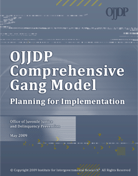OJJDP Comprehensive Gang Model Implementation Manual
The implementation manual Planning for Implementation provides a guide to development of a plan to implement the OJJDP Comprehensive Gang Model (Model). It relies heavily on the experiences, lessons learned, and best practices in more than 20 communities that have implemented the Model. The manual provides guidance for creating an implementation plan, outlines the administrative structure necessary to implement the Model, and describes recommended activities for each of the five core strategies of the Model.
Download PDF
View the Entire Document
- Implementation Manual
“Planning for Implementation”
Individual Chapters
- Introduction
This chapter describes the genesis of the OJJDP Comprehensive Gang Model.
- The OJJDP Comprehensive Gang Model
This chapter overviews the five core strategies of the Model—community mobilization, social intervention, opportunities provision, suppression, and organizational change and development. It also provides key elements that must be in place for successful implementation.
- Planning for Implementation
This chapter contains a step-by-step planning process for development of a plan to implement the Model. Worksheets are provided to facilitate organization of information and plan development.
- Five Core Strategies
The Model provides a framework for implementing five core strategies. Recommended activities for each strategy are included.
- Administrative Structure for Implementation
This chapter describes the administrative structure necessary for successful implementation: Steering Committee, Lead Agency, Project Director, Intervention Team, and Research Partner. It describes roles and responsibilities for each, as well as sample job descriptions.
- Prevention, Intervention, and Suppression
A multistrategy approach to gangs should include prevention, intervention, and suppression activities. This chapter reviews gang prevention (primary and secondary), intervention, and suppression strategies that should be considered during implementation.
- The Intervention Team
The multidisciplinary Intervention Team serves as the heart of the Model, bringing together key agencies to provide coordinated services to gang members. This chapter overviews the functions and administration of the Intervention Team, from selection of team members to screening clients and information sharing. Sample referral, intake, and consent forms are provided.
- Team-Based Case Management of Gang-Involved Clients
This chapter describes the case management work of the Intervention Team, including conducting needs assessments and developing intervention plans. The role of each agency in providing intervention services is discussed.
- The Role of Street Outreach in the Comprehensive Gang Model
Street outreach is a vital component of the Model and serves a crucial role in engaging difficult to serve gang-involved clients. This chapter describes the role of street outreach, as well as hiring and supervision protocols. A sample job description is provided.
- Evaluation and Sustainability
The Model is a data-driven approach to gangs that incorporates evaluation activities from the point of implementation. This chapter discusses evaluation protocols and lessons learned by projects that have been sustained by key community agencies.
- Resources


